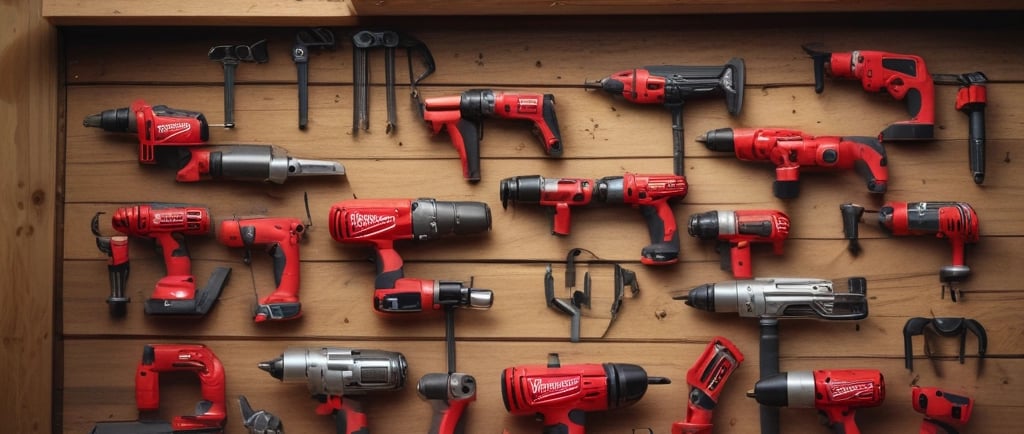How to Maintain Milwaukee Tools for Peak Performance
MILWAUKEE GENERAL
10/29/20254 min read


Understanding Your Milwaukee Tools
Milwaukee Tools is renowned for its innovative and high-quality product lineup, which includes a variety of tool types designed to meet the needs of professionals and DIY enthusiasts alike. The major categories offered by Milwaukee are cordless, corded, and hand tools. Each type serves distinct functions and advantages, catering to a wide array of applications from construction to automotive repair.
Cordless tools, powered by lithium-ion batteries, provide unmatched flexibility and ease of use, making them ideal for tasks that require mobility. Milwaukee's line of cordless drills, saws, and impact wrenches exemplifies this versatility, empowering users to work efficiently without the constraints of power cords. In contrast, corded tools are often favored for their consistent power supply, particularly in demanding operations where prolonged use is necessary. Models like the Milwaukee rotary hammer and angle grinders illustrate the robustness of corded options, ensuring they can handle heavy-duty tasks effectively.
Hand tools constitute another essential category, ranging from wrenches and screwdrivers to pliers and measuring instruments. These tools are designed for precision and are often the first choice for detailed work, assembly, and repair tasks. Understanding the specific application of each tool type enhances user efficiency and safety, making it crucial for owners to familiarize themselves with their equipment.
Furthermore, recognizing the importance of adhering to the manufacturer's guidelines for maintenance cannot be overstated. Each Milwaukee tool comes with a set of instructions that details proper cleaning, storage, and maintenance routines. Following these protocols not only helps sustain peak performance but also extends the lifespan of the tools. By understanding the unique maintenance needs of various models, users will be better equipped to keep their Milwaukee tools operating smoothly and efficiently.
Regular Cleaning and Care
Maintaining your Milwaukee tools through regular cleaning and care is essential to ensure their peak performance and longevity. Dust, debris, and contaminants can accumulate on tools, which may hinder their functionality and lead to premature wear. To effectively clean your tools, begin by disconnecting them from power sources and removing any attachments or accessories. This precaution helps to avoid any accidental activation during the cleaning process.
For the removal of dust and loose debris, a soft brush or a dry cloth works well for most tools. It is recommended to use gentle sweeping motions to avoid scratching sensitive surfaces. For more stubborn dirt or grime, a mild cleaning solution mixed with water can be applied. Always ensure that the cleaning agent chosen is compatible with the materials of the tool. For instance, using a lubricant, such as a silicone spray, can help maintain moving parts while preventing rust and corrosion.
Moreover, it is advisable to inspect the tool's components during the cleaning process. Look for any signs of wear, rust, or damage, particularly in areas exposed to moisture. Addressing these issues promptly is vital in preventing further deterioration. After cleaning, always dry the tool thoroughly to prevent moisture accumulation.
Creating a checklist based on tool usage frequency will help manage regular maintenance. For tools utilized frequently, a thorough cleaning session should occur every month, while tools used less often may require cleaning every few months. Additionally, maintaining the aesthetics of Milwaukee tools enhances their lifespan and ensures a professional appearance. By implementing these regular cleaning and care practices, users can significantly boost the performance and durability of their Milwaukee tools, keeping them in optimal condition for years to come.
Routine Inspections and Upkeep
Maintaining Milwaukee tools for optimal performance necessitates a consistent routine of inspections and upkeep. Conducting regular assessments not only ensures their efficiency but also extends their lifespan. One of the primary aspects to focus on during these inspections is checking for loose screws. Over time, screws can loosen due to the vibrations generated during operation, which could hinder the tool's performance. Tightening these components can prevent further issues and improve safety.
Another critical area to monitor is the condition of blades and cutting edges. Dull or worn blades can lead to increased strain on the motor and ultimately affect the quality of the work. Inspect the blades regularly for signs of wear, such as nicks or excessive dullness, and replace them as necessary. Additionally, keep an eye on other components like drill bits, saw blades, and chisels, as they may also require replacement based on usage.
Battery performance must not be overlooked in routine inspections. For cordless Milwaukee tools, batteries can degrade over time. Look out for signs of swelling or corrosion, which indicate that they may need replacement. Moreover, monitoring charge cycles can help in assessing battery health. Regularly review the tool’s performance and gauge how long a charge lasts to ensure optimal operation.
When performing these inspections, it is vital to maintain a maintenance log. This log should document any issues observed, repairs made, and replacements conducted. It serves as a reference for identifying recurring problems and gauging overall tool health. Should the inspections reveal issues beyond simple repairs, seeking professional assistance is advisable. Professional technicians can provide thorough diagnostics and specialized knowledge when complex repairs or maintenance are required. By adhering to these routine inspections and upkeep practices, tool owners can ensure that their Milwaukee tools operate at peak performance for years to come.
Storage and Handling Best Practices
Proper storage and handling are crucial elements in maintaining Milwaukee tools for optimal performance and longevity. To begin with, it is essential to store these tools in a clean, dry environment, free from excessive humidity and extreme temperatures. Humidity can lead to rust and corrosion, while extreme temperatures can adversely affect the integrity of battery life and tool components. Ideally, a dedicated storage area equipped with climate control should be the primary option for tool management.
Utilizing protective cases or tool organizers can significantly extend the lifespan of Milwaukee tools. These cases not only safeguard the tools from dust and moisture but also provide a designated space that can prevent potential damage from accidental falls or impacts. When selecting storage solutions, ensure they are compatible with the specific tools and allow for easy accessibility while maintaining organization.
Moreover, the way tools are handled during use plays an equally important role. Employing ergonomic practices can reduce strain on the user while also preventing unintentional damage to the tools. For instance, always use the tool as intended, following the manufacturer’s guidelines for operation. When transporting Milwaukee tools, utilize padded bags or supports that can absorb shocks. This practice avoids impacts that could otherwise compromise tool functionality.
In addition to these tips, regular inspections and maintenance are necessary to identify any wear and tear before they escalate into more significant issues. Ensuring all attachments are compatible and securely fitted can also prevent mishaps during use. By adopting these storage and handling best practices, users can effectively prolong the lifespan of their Milwaukee tools while ensuring they operate at peak performance whenever required.
